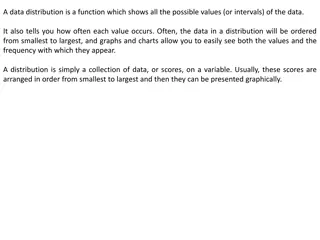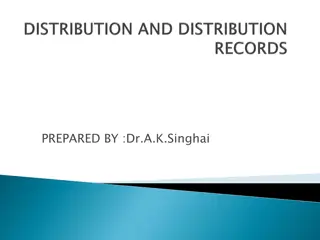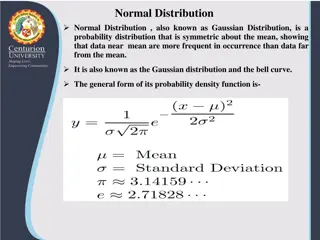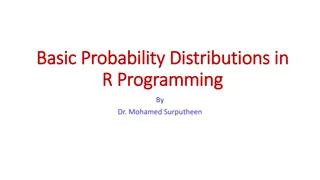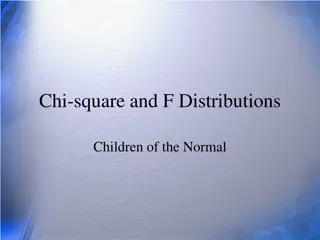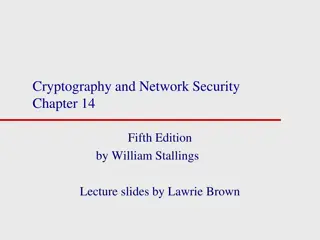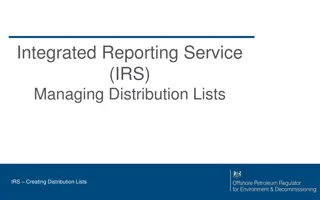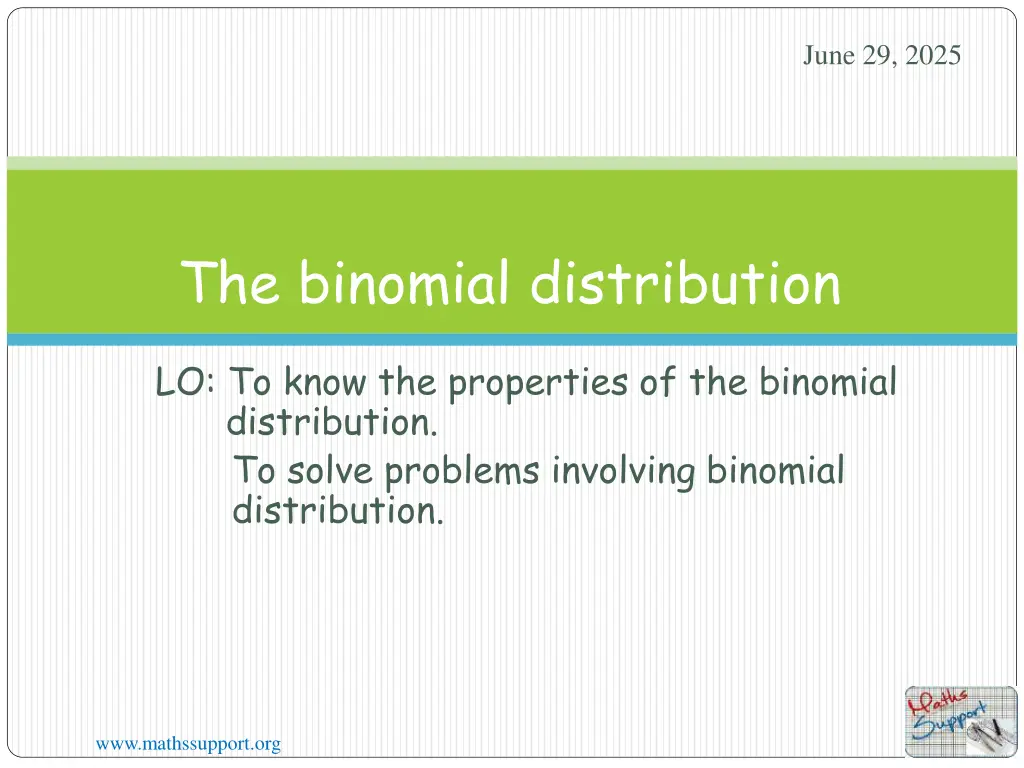
Understanding Binomial Distribution in Experiments
Learn about binomial experiments, the properties of the binomial distribution, and how to set up a binomial distribution to calculate probabilities for different outcomes. Explore examples and conditions that define a unique binomial distribution.
Download Presentation

Please find below an Image/Link to download the presentation.
The content on the website is provided AS IS for your information and personal use only. It may not be sold, licensed, or shared on other websites without obtaining consent from the author. If you encounter any issues during the download, it is possible that the publisher has removed the file from their server.
You are allowed to download the files provided on this website for personal or commercial use, subject to the condition that they are used lawfully. All files are the property of their respective owners.
The content on the website is provided AS IS for your information and personal use only. It may not be sold, licensed, or shared on other websites without obtaining consent from the author.
E N D
Presentation Transcript
June 29, 2025 The binomial distribution LO: To know the properties of the binomial distribution. To solve problems involving binomial distribution. www.mathssupport.org
Binomial experiment. DEFINITION OF BINOMIAL EXPERIMENT. A binomial experiment is an experiment in which there are two outcomes. EXAMPLE: We roll a die. There are 6 possible results ( outcomes ): 1, 2, 3, 4, 5 or 6. However, if we are interested in getting a 6, we could say the trial has only 2 outcomes: a 6 or not a 6. Now it is a Binomial experiment Lots of experiments can be thought of as having 2 outcomes. e.g. A seed is sown and the flower is either yellow or not yellow. e.g. A computer chip is taken off a production line and it either works or it doesn t. www.mathssupport.org
Binomial experiment. The 2 possible outcomes of these experiments are called success and failure. We will label the probability of success as p and failure as q. What can you say about p + q ? p + q = 1 since no other outcomes are possible. Suppose that we repeat a trial several times and the probability of success doesn t change from one trial to the next. Suppose also that each result has no effect on the result of the other trials. With these conditions all satisfied, we can use the binomial model to estimate the probability of success and to estimate the mean. The trials are independent. www.mathssupport.org
Binomial experiment. The Binomial distribution can be used to model a situation if all of the following conditions are met: Each trial has only two possible outcomes, success and failure. The trial is repeated n times. The probability of success in one trial is p and p is constant from trial to trial. The trials are independent of each other. The binomial distribution describes the behavior of a discrete variable X if the conditions above apply The parameters that define a unique binomial distribution are the values of n and p. Any binomial distribution is represented as X ~ B(n, p) www.mathssupport.org
Binomial experiment. EXAMPLE. We roll a fair die 4 times and we count the number of sixes. Determine if the experiment satisfies the conditions to be considered binomial. There are 4 trials There are 2 outcomes to each trial. ( Success is getting a 6 and failure is not getting a 6 ). There is a constant probability of success ( getting a 6 ), so ? =? ? for every trial. The trials are independent. This experiment satisfies the conditions for the binomial model. www.mathssupport.org
Setting up a Binomial Distribution A probability distribution gives the probabilities for all possible values of a variable. We are now going to find these probabilities using an example. It will result in a formula to calculate this probability and is very easy to use. Consider the experiment of rolling the die 5 times. Suppose we need to find the probability of getting 3 sixes. www.mathssupport.org
Find the probability of getting three sixes. We need to do two things: Find the probability of getting 6, 6, 6, 6 , 6 (in that order ) where 6 is not a six and Find the number of ways of getting 3 sixes (in any order ). We know the probability of getting a 6 if we roll the die once is given by 1 = = ) 6 ( P 6 If we roll the die again the outcome is independent of the 1st outcome, so we can use the formula if A and B are independent 2 1 = = and A B A B P P P ( ) ( ) ( ) 1 1 giving = = 6 ( , P = = ) 6 and ) 6 6 ( P = = 6 6 6 www.mathssupport.org
Find the probability of getting three sixes. 3 1 Then, P(6, 6, 6) = 6 Now we have the probability of 3 sixes, we want the last 2 rolls to give anything except a six. The probability of not getting a six is given by: ) 6 ( P 5 = P = = 1 ) 6 ( 6 3 1 5 ) = 6 , 6 , 6 6 ( , P So, 6 6 And finally, 3 2 1 5 6 , = 6 , 6 , 6 6 ( , P ) 6 6 www.mathssupport.org
Find the probability of getting three sixes. 3 2 1 5 6 , So, = 6 , 6 , 6 6 ( , P ) 6 6 Now we need the number of ways of getting 3 sixes. 6 6 6 6 6 6 6 6 6 6 6 6 6 6 6 6 6 6 6 6 6 6 6 6 6 6 6 6 6 6 6 6 6 6 6 6 6 6 6 6 6 6 6 6 6 6 6 6 6 6 Fortunately we don t have to do this all the time! If we think of it as choosing the 3 positions for the sixes after rolling the dice 5 times, we realise that we have = 3 3 5 5C = 10 www.mathssupport.org
Find the probability of getting three sixes. We now have that after rolling the dice 5 times the probability of getting 6, 6, 6, 6 , 6 ( in any order ) is 3 2 1 6 5 6 the number of ways of getting 3 sixes in any order is 5C3 So the probability of 3 sixes ( in any order ) is 3 2 1 6 5 6 5C3 www.mathssupport.org
Find the probability of getting three sixes. If X is the random variable the number of sixes when a die is rolled 5times then X has a binomial distribution and ? ? ? ? ? ? P(X = 3) = 5C3 Tip: For any binomial probability, these numbers . . . are equal www.mathssupport.org
Find the probability of getting three sixes. If X is the random variable the number of sixes when a die is rolled 5times then X has a binomial distribution and ? ? ? ? ? ? P(X = 3) = 5C3 and this . . . is the sum of these www.mathssupport.org
Find the probability of getting three sixes. We can simplify the expression using a calculator: 3 2 1 5 = = = ( ) 3 P X C ( 4 d.p. ) 0 0322 5 3 6 6 We can find the probabilities of getting 0, 1, 2, 4 and 5 sixes in the same way. 1 1 1 0 5 = C 0 5 5 1 C = = ) 0 = = = = 0 P (X 4019 5 0 6 6 5 Tip: It saves some fiddling on the calculator if you remember that 1 4 and C = = ) 1 = = 0 = = 0 = P (X 4019 1 5 1 6 6 6 = 5 C Can you find the probabilities that X = 2 and X = 4 and X = 5 ? ( Give the answers correct to 4 d.p. ) It s useful to remember that 5 1 www.mathssupport.org
The probabilities are: 0 5 1 5 = ) 0 = (X C P = = 0 4019 5 0 6 1 6 5 1 4 = ) 1 = C (X P = = 0 4019 5 1 6 1 6 5 2 3 = = 0 = ) 2 = 1608 C (X P 5 2 6 6 3 2 1 5 = = = ( ) 3 P X C 0 0322 5 3 6 1 6 5 4 1 = = = ( ) 4 P X C 0 0032 5 4 6 6 Since the sum of the probabilities is 1, I added the P(X = 5) = 0.0001 = 0.000128 The probability correct to 4 d.p. others and subtracted from 1. www.mathssupport.org
Binomial distribution function. In general, if X is a random variable binomially distributed, then we write X where n is the number of trials and p is the probability of success in one trial. The probability ofobtainingr successes out of n independent trials, when p is the probability of success for each trial, is P(X= r)= nCr pr qn r = ? ~ ( , ) B n p ? pr qn r where q = 1 p (The Binomial distribution is just a special case of a discrete probability distribution) www.mathssupport.org
Binomial distribution problems. Example 1 X is binomially distributed with 6 trials and a probability of success equal to 1 What is the probability of (a) Exactly four successes. (b)At least one success. (c) Three or fewer successes. Solution: n = 6 If X ~ B 6,1 (a) P(X= 4) 5 at each attempt. Using this notation X ~ B ?,? You can rewrite the question as p = 1 5 P(X= r)= ? Using this formula 5 ? pr qn r r = 4 ? ? P(X= 4)= 6 ? ? ? ? 4 625 16 1 = 0.01536 = 15 25 www.mathssupport.org
Binomial distribution problems. Example 1 X is binomially distributed with 6 trials and a probability of success equal to 1 What is the probability of (a) Exactly four successes. (b)At least one success. (c) Three or fewer successes. Solution: You can rewrite the question as 5 at each attempt. Using this notation X ~ B ?,? n = 6 If X ~ B 6,1 (b) P(X 1) It is quicker to calculate 1 P(X = 0) p = 1 5 P(X= r)= ? ? pr qn r 5 r = 0 ? ? P(X= 0)= 6 ? ? 4 5 ? ? 0 6 = 1 = 0.738 www.mathssupport.org
Binomial distribution problems. Example 1 X is binomially distributed with 6 trials and a probability of success equal to 1 What is the probability of (a) Exactly four successes. (b)At least one success. (c) Three or fewer successes. Solution: n = 6 If X ~ B 6,1 (c) P(X 3) =P(X= 0)+ P(X= 1)+ P(X= 2) + P(X= 3) 5 at each attempt. Using this notation X ~ B ?,? You can rewrite the question as p = 1 5 5 ? ?+ 6 ? ?+ 6 ? ?+ 6 ? ? P(X 3)= 6 ? ? ? ? ? ? ? ? ? ? ? ? ? ? ? ? 0 1 2 3 6 ? ? ? ? ? ? 4 5 ? ? ? ? ? ? ? ? ? ? ? ? = = 0.983 +6 +15 +20 www.mathssupport.org
Using GDC for Binomial distribution problems. Example 2 X is a discrete random variable and X ~ B(20, 0.45) Calculate the probability that (a) X is less than or equal to 10. (b) X lies between 5 and 10 inclusive. (c) X is greater than 11. Solution: X ~ B ?,? Using this notation = 0 = 10 Lower bound Upper bound = 20 Number of trials Probability Turn on the calculator Click 2nd = 0.45 distr www.mathssupport.org
Using GDC for Binomial distribution problems. Example 2 X is a discrete random variable and X ~ B(20, 0.45) Calculate the probability that (a) X is less than or equal to 10. (b) X lies between 5 and 10 inclusive. (c) X is greater than 11. Solution: Using this notation X ~ B ?,? Lower bound = 0 Upper bound = 10 Number of trials = 20 Probability = 0.45 Scroll to B binomcdf enter www.mathssupport.org
Using GDC for Binomial distribution problems. Example 2 X is a discrete random variable and X ~ B(20, 0.45) Calculate the probability that (a) X is less than or equal to 10. (b) X lies between 5 and 10 inclusive. (c) X is greater than 11. Solution: Using this notation X ~ B ?,? Lower bound = 0 Upper bound = 10 Trials = 20 p = 0.45 Number of trials = 20 Probability = 0.45 x value = 10 enter enter www.mathssupport.org
Using GDC for Binomial distribution problems. Example 2 X is a discrete random variable and X ~ B(20, 0.45) Calculate the probability that (a) X is less than or equal to 10. (b) X lies between 5 and 10 inclusive. (c) X is greater than 11. Solution: Using this notation X ~ B ?,? P(X 10) 0.751 Rounded to 3sf www.mathssupport.org
Using GDC for Binomial distribution problems. Example 2 X is a discrete random variable and X ~ B(20, 0.45) Calculate the probability that (a) X is less than or equal to 10. (b) X lies between 5 and 10 inclusive. (c) X is greater than 11. Solution: X ~ B ?,? We need the sum of these probabilities P(5) + P(6) + P(7) + P(8) + P(9) + P(10) Click 2nd catalog Scroll to sum Using this notation www.mathssupport.org
Using GDC for Binomial distribution problems. Example 2 X is a discrete random variable and X ~ B(20, 0.45) Calculate the probability that (a) X is less than or equal to 10. (b) X lies between 5 and 10 inclusive. (c) X is greater than 11. Solution: X ~ B ?,? We need the sum of these probabilities P(5) + P(6) + P(7) + P(8) + P(9) + P(10) Click 2nd catalog Scroll to sum enter Click 2nd distr Using this notation www.mathssupport.org
Using GDC for Binomial distribution problems. Example 2 X is a discrete random variable and X ~ B(20, 0.45) Calculate the probability that (a) X is less than or equal to 10. (b) X lies between 5 and 10 inclusive. (c) X is greater than 11. Solution: X ~ B ?,? We need the sum of these probabilities P(5) + P(6) + P(7) + P(8) + P(9) + P(10) Click 2nd catalog Scroll to sum enter Click 2nd distr Using this notation Scroll to A binompdf enter www.mathssupport.org
Using GDC for Binomial distribution problems. Example 2 X is a discrete random variable and X ~ B(20, 0.45) Calculate the probability that (a) X is less than or equal to 10. (b) X lies between 5 and 10 inclusive. (c) X is greater than 11. Solution: X ~ B ?,? We need the sum of these probabilities P(5) + P(6) + P(7) + P(8) + P(9) + P(10) Type in the following: Using this notation Trials: 20 0.45 p: enter enter x value: {5, 6, 7, 8, 9, 10} www.mathssupport.org
Using GDC for Binomial distribution problems. Example 2 X is a discrete random variable and X ~ B(20, 0.45) Calculate the probability that (a) X is less than or equal to 10. (b) X lies between 5 and 10 inclusive. (c) X is greater than 11. Solution: X ~ B ?,? Using this notation P(5 X 10) 0.732 Rounded to 3sf www.mathssupport.org
Using GDC for Binomial distribution problems. Example 2 X is a discrete random variable and X ~ B(20, 0.45) Calculate the probability that (a) X is less than or equal to 10. (b) X lies between 5 and 10 inclusive. (c) X is greater than 11. Solution: X ~ B ?,? We are going to calculate 1 P(x 11) Type 1 - Click clear Click 2nd distr Scroll to B binomcdf enter Trials = 20 p = 0.45 Using this notation Type this values enter enter x value = 11 www.mathssupport.org
Using GDC for Binomial distribution problems. Example 2 X is a discrete random variable and X ~ B(20, 0.45) Calculate the probability that (a) X is less than or equal to 10. (b) X lies between 5 and 10 inclusive. (c) X is greater than 11. Solution: X ~ B ?,? Using this notation P(X 11) 0.131 Rounded to 3sf www.mathssupport.org
Thank you for using resources from A close up of a cage Description automatically generated For more resources visit our website https://www.mathssupport.org If you have a special request, drop us an email info@mathssupport.org www.mathssupport.org











